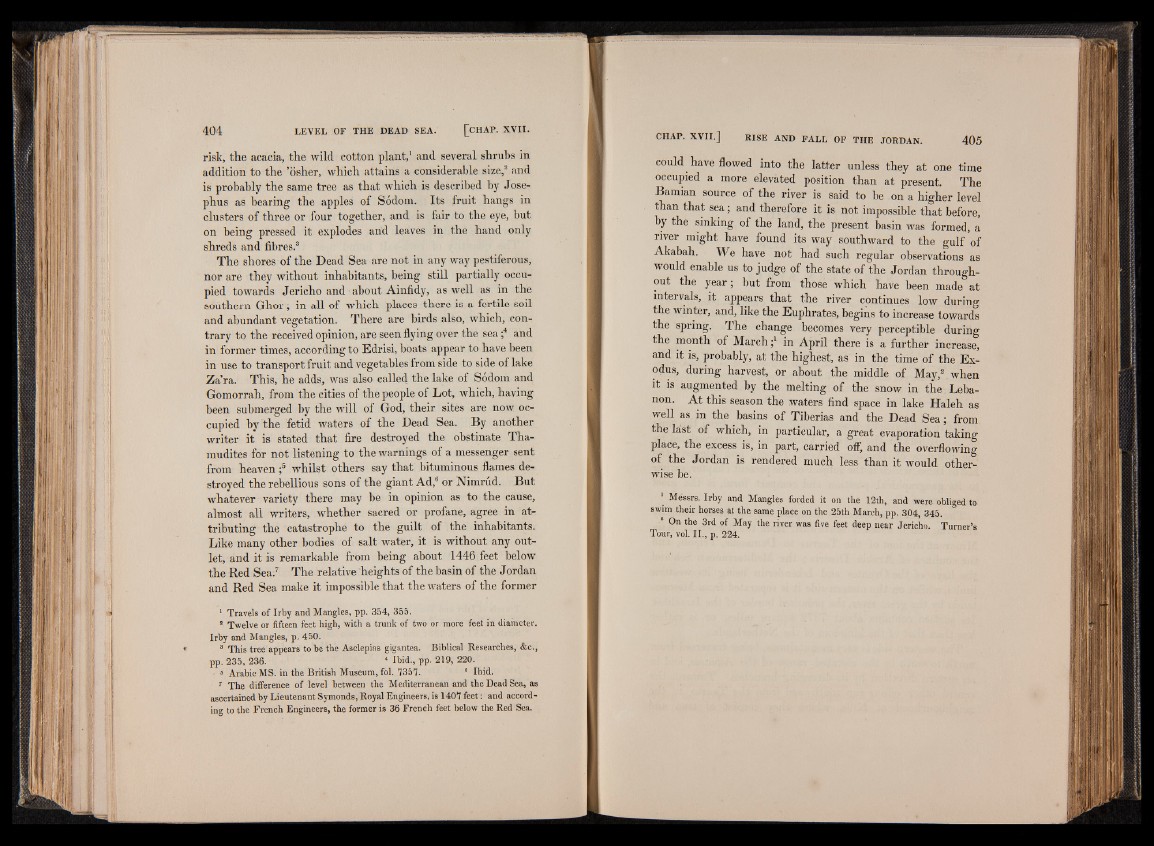
risk, the acacia, the wild cotton plant,1 and several shrubs in
addition to the ’osher, which attains a considerable size,2 and
is probably the same tree as that which is described by Josephus
as bearing the apples of Sodom. Its fruit hangs in
clusters of three or four together, and is fair to the eye, but
on being pressed it explodes and leaves in the hand only
shreds and fibres.3
The shores of the Dead Sea are not in any way pestiferous,
nor are they without inhabitants, being still partially occupied
towards Jericho and about Ainfidy, as well as in the
southern Glior; in all of which places there is a fertile soil
and abundant vegetation. There are birds also, which, contrary
to the received opinion, are seen flying over the sea ;4 and
in former times, according to Edrisi, boats appear to have been
in use to transport fruit and vegetables from side to side of lake
Za’ra. This, he adds, was also called, the lake of Sodom and
Gomorrah, from the cities of the people of Lot, which, having
been submerged by the will of God, their sites are now occupied
by the fetid waters of the Dead Sea. By another
writer it is stated that fire destroyed the obstinate Tha-
mudites for not listening to the warnings of a messenger sent
from heaven ;5 whilst others say that bituminous flames destroyed
the rebellious sons of the giant Ad,6 or Nimrud. But
whatever variety there may be in opinion as to the cause,
almost all writers, whether sacred or profane, agree in attributing
the catastrophe to the guilt of the inhabitants.
Like many other bodies of salt water, it is without any outlet,
and it is remarkable from being about 1446 feet below
the Red Sea.7 The relative heights of the basin of the Jordan
and Red Sea make it impossible that the waters of the former
1 Travels of Irby and Mangles, pp. 354, 355.
* Twelve or fifteen feet high, with a trunk of two or more feet in diameter.
Irby and Mangles, p. 450.
3 This tree appears to he the Asclepias gigantea. Biblical Researches, &c.,
pp. 235, 236. I Ibid., pp. 219, 220.
5 Arabic MS. in the British Museum, fol. 1351. 6 Ibid.
7 The difference of level between the Mediterranean and the Dead Sea, as
ascertained by Lieutenant Symonds, Royal Engineers, is 1401 feet: and according
to the French Engineers, the former is 36 French feet below the Red Sea.
could have flowed into the latter unless they at one time
occupied a more elevated position than at present. The
Bamian source of the river is said to be on a higher level
than that sea; and therefore it is not impossible that before,
by the sinking of the land, the present basin was formed, a
river might have found its way southward to the gulf of
Akabah. We have not had such regular observations as
would enable us to judge of the state of the Jordan throughout
the year; but from those which have been made at
intervals, it appears that the river continues low during
the winter, and, like the Euphrates, begins to increase towards
the spring. The change becomes very perceptible during
the month of March in April there is a further increase,
and it is, probably, at the highest, as in the time of the Exodus,
during harvest, or about the middle of May,2 when
it is augmented by the melting of the snow in the Lebanon.
At this season the waters find space in lake Haleh as
well as in the basins of Tiberias and the Dead Sea; from
the last of which, in particular, a great evaporation taking
place, the excess is, in part, carried off, and the overflowing
of the Jordan is rendered much less than it would otherwise
be.
1 Messrs. Irby and Mangles forded it on the 12th, and were obliged to
swim their horses at the same place on the 25th March, pp. 304, 345.
2 On the 3rd of May the river was five feet deep near Jericho. Turner’s
Tour, vol. II., p. 224.